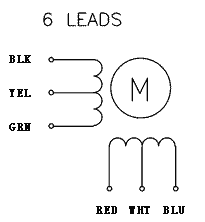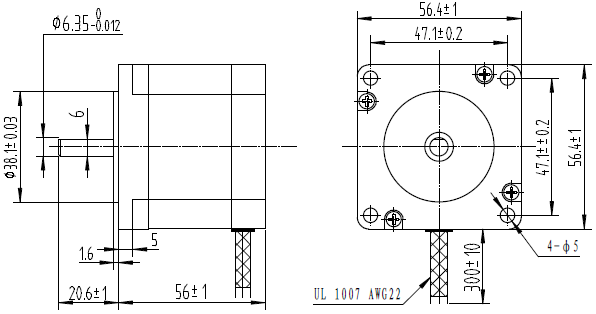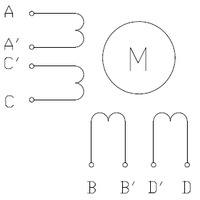This NEMA 23-size hybrid stepping motor can be used as a unipolar or bipolar stepper motor and has a 1.8° step angle (200 steps/revolution). Each phase draws 1 A at 7.4 V, allowing for a holding torque of 9 kg-cm (125 oz-in).
Special Order
Shipping from $10.90
+124 more from our supplier in 7-10 days
Our Code: SKU-002614
Supplier Link: [Pololu MPN:1472]
 |
| 6-lead, unipolar/bipolar stepper motor wiring diagram. |
|---|
This high-torque hybrid stepping motor has a 1.8° step angle (200 steps/revolution). Each phase draws 1 A at 7.4 V, allowing for a holding torque of 9 kg-cm (125 oz-in). The motor has six colour-coded wires terminated with bare leads that allow it to be controlled by both unipolar and bipolar stepper motor drivers. When used with a unipolar stepper motor driver, all six leads are used. When used with a bipolar stepper motor driver, the centre-tap yellow and white wires can be left disconnected (the red-blue pair gives access to one coil and the black-green pair gives access to the other coil). We recommend using it as a bipolar stepper motor.
Our 1/4″ universal mounting hub and 1/4″ scooter wheel adaptor can be used to mount objects on the stepper motor’s 1/4″-diameter output shaft, and we carry a NEMA 23 steel bracket for securely mounting this stepper motor to a flat surface (the picture above shows this bracket being used with a taller NEMA 23 stepper motor).
More specifications are available in the datasheet (46k pdf).
The following diagram shows the stepper motor dimensions in mm. The output D-shaft has a 0.25″ (6.35 mm) diameter with a section that is flattened by 0.5 mm (note: the diagram below incorrectly lists this flattened width as 6 mm when it is really 5.85 mm). This shaft works with our 1/4″ universal mounting hub and 1/4″ scooter wheel adaptor.
 |
Stepper motors are generally used in a variety of applications where precise position control is desirable and the cost or complexity of a feedback control system is unwarranted. Here are a few applications where stepper motors are often found:
Note: This stepper motor is SOYO part number SY57STH56-1006A.
| Size: | 56.4 mm square × 56 mm1 |
|---|---|
| NEMA size: | 23 |
| Weight: | 700 g |
| Shaft diameter: | 6.35 mm |
| Shaft type: | 1/4 inch "D" |
|---|---|
| Steps per revolution: | 200 |
| Current rating: | 1000 mA2 |
| Voltage rating: | 7.4 V |
| Holding torque: | 125 oz·in |
| Resistance: | 7.4 Ohm2 |
| Inductance per phase: | 10 mH |
| Number of leads: | 6 |
| Lead length: | 30 cm |
Yes. To avoid damaging your stepper motor, you want to avoid exceeding the rated current, which is 600 mA in this instance. The A4988 stepper motor drivers let you limit the maximum current, so as long as you set the limit below the rated current, you will be within spec for your motor, even if the voltage exceeds the rated voltage. The voltage rating is just the voltage at which each coil draws the rated current, so the coils of your stepper motor will draw 600 mA at 3.9 V. By using a higher voltage along with active current limiting, the current is able to ramp up faster, which lets you achieve higher step rates than you could using the rated voltage.
If you do want to use a lower motor supply voltage (under 8 V) for other reasons, consider using our DRV8834 low-voltage stepper motor driver carrier.
The answer to this question depends on the type of stepper motor you have. When working with stepper motors, you will typically encounter two types: unipolar stepper motors and bipolar stepper motors. Unipolar motors have two windings per phase, allowing the magnetic field to be reversed without having to reverse the direction of current in a coil, which makes unipolar motors easier to control than bipolar stepper motors. The drawback is that only half of the phase is carrying current at any given time, which decreases the torque you can get out of the stepper motor. However, if you have the appropriate control circuitry, you can increase the stepper motor torque by using the unipolar stepper motor as a bipolar stepper motor (note: this is only possible with 6- or 8-lead unipolar stepper motors, not with 5-lead unipolar stepper motors). Unipolar stepper motors typically have five, six, or eight leads.
Bipolar steppers have a single coil per phase and require more complicated control circuitry (typically an H-bridge for each phase). The A4983 and A4988 have the circuitry necessary to control a bipolar stepper motor. Bipolar stepper motors typically have four leads, two for each coil.
 |
| Two-phase bipolar stepper motor with four leads. |
|---|
The above diagram shows a standard bipolar stepper motor. To control this with the A4983 or A4988, connect stepper lead A to board output 1A, stepper lead C to board output 1B, stepper lead B to board output 2A, and stepper lead D to board output 2B. See the A4983/A4988 datasheet for more information.
If you have a six-lead unipolar stepper motor as shown in the diagram below:
 |
| Two-phase unipolar stepper motor with six leads. |
|---|
you can connect it to the A4983 or A4988 as a bipolar stepper motor by making the bipolar connections described in the section above and leaving stepper leads A’ and B’ disconnected. These leads are centre taps to the two coils and are not used for bipolar operation.
If you have an eight-lead unipolar stepper motor as shown in the diagram below:
 |
| Two-phase unipolar stepper motor with eight leads. |
|---|
you have several connection options. An eight-lead unipolar stepper motor has two coils per phase, and it gives you access to all of the coil leads (in a six-lead unipolar motor, lead A’ is internally connected to C’ and lead B’ is internally connected to D’). When operating this as a bipolar stepper, you have the option of using the two coils for each phase in parallel or in series. When using them in parallel, you decrease coil inductance, which can lead to increased performance if you have the ability to deliver more current. However, since the A4983 and A4988 actively limit the output current per phase, you will only get half the phase current flowing through each of the two parallel coils. When using them in series, it’s like having a single coil per phase (like in four-lead bipolar steppers or six-lead unipolar steppers used as bipolar steppers). We recommend you use a series connection.
To connect the phase coils in parallel, connect stepper leads A and C’ to board output 1A, stepper leads A’ and C to board output 1B, stepper leads B and D’ to board output 2A, and stepper leads B’ and D to board output 2B.
To connect the phase coils in series, connect stepper lead A’ to C’ and stepper lead B’ to D’. Stepper leads A, C, B, and D should be connected to the stepper motor driver as normal for a bipolar stepper motor (see the bipolar stepper connections above).